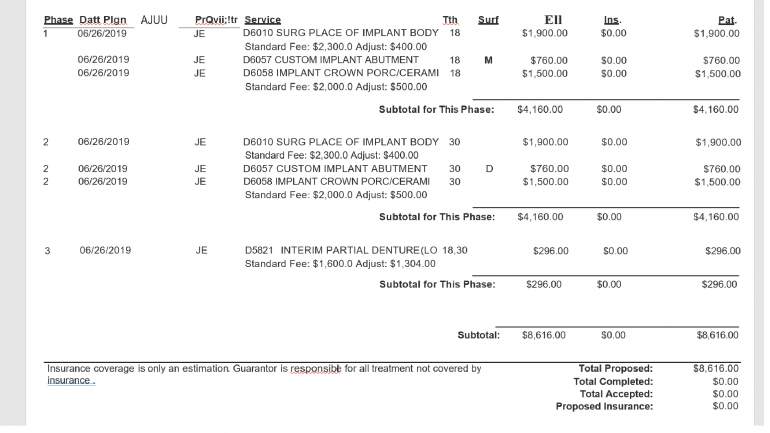
Dental Code D7240: Removal of Impacted Tooth - Completely Bony
Dental Code D7240 is a dental procedure that involves the removal of an impacted tooth that is fully encased in bone. This specific dental code is used to identify and bill for the treatment provided by dentists or oral surgeons in cases where a tooth fails to fully emerge or erupt into its normal position within the dental arch.
Price Ranges & Savings D7240
On average, patients pay $500 for this D7240 service at the dentist's office, with as little as $400 charged for this in less expensive cities and as much as $700 in more expensive cities.
Low cost of living | Medium cost of living | High cost of living |
Memphis (Tennessee), Cincinnati (Ohio) | Miami (Florida), Denver (Colorado), Austin (Texas) | (New York (New York), San Francisco (California) |
$400 | $500 | $700 |
However, the price for the service D7240 depends not only on the region where you live, but also varies from dentist to dentist. Therefore, it makes sense to compare prices before choosing a dentist. The best way to do this price comparison is at Dr. BestPrice and save a lot of money.
What does Dental Code D7240 mean? Detailed information about the procedure and the steps of the whole process
Dental Code D7240 refers to the removal of an impacted tooth that is completely encased in bone. This procedure is necessary when a tooth fails to fully emerge or erupt into its normal position within the dental arch. The process involves several steps, including an initial assessment and diagnosis, pre-operative preparation, administration of anesthesia, making an incision and accessing the impacted tooth, gentle extraction of the tooth, and closure of the surgical site. Post-operative care instructions are provided to ensure proper healing and recovery. Consulting with a dentist or oral surgeon is crucial to understanding the specific details of the procedure and addressing any concerns. Following the recommended treatment plan and post-operative care guidelines promotes successful outcomes and optimal oral health.
Initial Assessment and Diagnosis
The first step in the removal of an impacted tooth is a comprehensive assessment and diagnosis conducted by a dentist or oral surgeon. The dental professional will review the patient's dental history, perform a detailed clinical examination, and may request additional imaging such as X-rays or a cone beam computed tomography (CBCT) scan. These diagnostic tools help determine the precise position of the impacted tooth, its relationship to surrounding structures, and plan the most appropriate course of action.
Pre-operative Preparation
Prior to the actual procedure, the patient will receive detailed instructions for pre-operative care. These instructions may include guidelines on fasting, managing medications, and possibly undergoing specific laboratory tests. It is crucial to follow these instructions carefully to ensure a smooth and safe surgical experience.
Administration of Anesthesia
On the day of the procedure, the dentist or oral surgeon will administer suitable anesthesia to ensure the patient's comfort during the surgery. The choice of anesthesia depends on various factors, including the complexity of the case and the patient's preferences. Local anesthesia is commonly used to numb the immediate area around the impacted tooth, preventing pain and discomfort during the procedure. In some cases, general anesthesia might be necessary, which induces temporary unconsciousness.
Incision and Access
Once the patient is adequately anesthetized, the dentist or oral surgeon will make an incision in the gum tissue to expose the impacted tooth. This incision is carefully planned to provide the best access while minimizing trauma to surrounding tissues. In certain situations, a small amount of bone might need to be removed to fully expose the impacted tooth.
Removal of the Impacted Tooth
With the tooth now visible, the dentist or oral surgeon will gently extract it from its bony socket. The extraction process may involve the use of specialized tools and techniques to facilitate safe and efficient removal. Elevators, which are thin, flat instruments, are often used to loosen the tooth from its surrounding bone. Forceps, designed to grasp and hold the tooth firmly, aid in the extraction process. The dentist or oral surgeon will exercise caution to avoid damaging adjacent teeth, nerves, or blood vessels during this delicate procedure.
Closure and Post-operative Care
After the impacted tooth is successfully removed, the dentist or oral surgeon will thoroughly clean the surgical site. In some cases, the incision may require sutures to aid in healing. The dental professional will provide the patient with post-operative care instructions, which typically include guidelines for pain management, oral hygiene practices, and dietary restrictions. Follow-up appointments will be scheduled to monitor the healing process and ensure proper recovery.
Summary of Dental Code D7240
Dental Code D7240 encompasses the removal of an impacted tooth that is entirely encased in bone. This procedure involves a series of steps, beginning with an initial assessment and diagnosis, followed by pre-operative preparation and the administration of appropriate anesthesia. The surgical process includes making an incision, gaining access to the impacted tooth, and gently extracting it from its bony socket. The surgical site is then cleaned, and if necessary, sutures are used for closure. The patient will be provided with post-operative care instructions to promote healing and optimal oral health.
To ensure a successful outcome and address any concerns, patients should consult with their dentist or oral surgeon. By following the recommended treatment plan and post-operative care guidelines, patients can achieve a smooth recovery and maintain good oral health.
Are you tired of spending too much on your dental health? Look no further than Dr.BestPrice, your ultimate companion for incredible savings!
